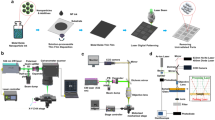Abstract
Metal nanostructures are used as wire grids for liquid crystal displays and lighting-receiving surface electrodes of solar cells. They are also integrated in emerging devices for chemical and biomedical detection and analyses carried out under various research and development programs. Currently, the mainstream fabrication method of metal nanostructures needs many manufacturing processes including patterning and metallization technologies. Here, our high-temperature nanoimprint technology for glass materials was applied to metals, which led to the development of technology to transfer nanopatterns onto a metal foil using a quartz mold. Although the glass transition temperature does not exist in metal but plastic deformation of metal is possible if the metal is made to re-crystallize at a high-temperature, but kept below its melting point. In our experiment, Al, Ag, and Cu foils of 100 μm thickness were bonded on a glass substrate of 1 mm thickness using an intermediation layer of the same metal. After that, a heated quartz mold was pressed against each metal foil, and nano-patterning was carried out. Within the limits of the specifications of a used thermal nanoimprint system, the optimal imprint temperature for Al, Ag, and Cu foils was 500, 600, and 650 °C respectively. For all metals the imprint pressure and holding time were set as 20 MPa and 1 h. As a result of trial experiments, on the three kinds of metal foils we succeeded in forming line/space with a minimum linewidth of 350 nm; and concave and convex square dotted patterns with a minimum width of 500 nm. This technique required imprint pressure less than used in conventional direct-nanoimprinting at the room temperature. With this technique of nanofabrication, molds with a low mechanical strength could be used.







Similar content being viewed by others
References
Cannon AH, King WP (2009) Casting metal microstructures from a flexible and reusable mold. J Micromech Microeng 19:095016. doi:10.1088/0960-1317/19/9/095016
Cheng M, Sung C, Wang WH (2007) The effects of thin-film thickness on the formaton of metallic patterns by direct nanoimprint. J Mater Proc Technol 191:326–330. doi:10.1016/j.jmatprotec.2007.03.049
del Campo A, Arzt E (2011) Generating micro- and nanopatterns on polymeric materials. Wiley, Weinheim
Kao Y, Hong FC (2011) Direct printing of silver nanoparticles by an agarose stamp on planar and patterned substrates. Nanotechnology 22:185303. doi:10.1088/0957-4484/22/18/185303
Lim SH, Saifullah MSM, Hussain H, Loh WW, Low HY (2010) Direct imprinting of high resolution TiO2 nanostructures. Nanotechnology 21:285303. doi:10.1088/0957-4484/21/28/285303
Lozinskii MG (1961) High temperature metallography. Pergamon Press, New York
Maugis D (1980) Creep, hot hardness and sintering in the adhesion of metals at high temperature. Wear 62:349–386. doi:10.1016/0043-1648(80)90179-9
Mekaru H, Takahashi M (2009) Imprinting a needle array on a polycarbonate substrate. Int J Precis Eng Manuf 10:79–83. doi:10.1007/s12541-009-0012-5
Mekaru H, Takano T, Awazu K, Takahashi M, Maeda R (2009a) Demonstration of fabricating a needle array by the combination of x-ray grayscale mask with the lithografie, galvanoformung, abformung process. J Micro/Nanolith MEMS MOEMS 8:033010. doi:10.1117/1.3158617
Mekaru H, Okuyama C, Ueno A, Takahashi M (2009b) Thermal imprinting on quartz fiber using glasslike carbon mold. J Vac Sci Technol, B 27:2820–2825. doi:10.1116/1.3250195
Mekaru H, Okuyama C, Ueno A (2012) Control of inclination angle of glass-like carbon mold by defocus UV exposure on Si-containing photoresist. J Vac Sci Technol B 30:06FB12. doi:10.1116/1.4766316
Mekaru H, Okuyama C, Ueno A (2013) Fabrication of glass-like carbon molds to imprint on glass materials by MEMS processing technologies. Microsyst Technol 19:315–323. doi:10.1007/s00542-012-1553-6
Pang SW, Tamamura T, Nakao M (1998) Direct nano-printing on Al substrate using a SiC mold. J Vac Sci Technol, B 16:1145–1149. doi:10.1116/1.590024
Pugh SF (1954) Relations between the elastic moduli and the plastic properties of polycrystalline pure metals. Philos Mag Ser 7(45):823–843. doi:10.1080/14786440808520496
Soga T (2006) Nanostructures materials for solar energy conversion. Elsevier, Amsterdam
Takahashi M, Goto H, Maeda R, Maruyama O (2006) Desktop nanoimprint system -prototype and performance. In: Proceedings of Japan Society for Precision Engineering Conference, Chiba, Japan, pp 737–738. (in Japanese)
Weilie Z, Lin WZ (2011) Three-dimensional nanoarchitectures. 1st edn. (designing next-generation devices) Springer, New York
Yao CH, Wu CL, Sung CK (2008) Effects of thin film properties on metallic pattern formation by direct nanoimprint. J Mater Proc Technol 201:765–769. doi:10.1016/j.jmatprotec.2007.11.303
Yeh P, Gu C (2009) Optics of liquid crystal displays, 2nd edn. Wiley, New Jersey
Yokoo A, Nakao M, Yoshikawa H, Masuda H, Tamamura T (1999) 63-nm-pitch pit pattern fabricated on polycarbonate surface by direct nanoprinting. Jpn J Appl Phys 38:7268–7271. doi:10.1143/JJAP.38.7268
Youn S, Ueno A, Okuyama C, Takagi H, Takahashi M, Maeda R (2009) Direct imprint of Al foil for metallization of high-aspect ratio Al lines in nano/micro patterned SiO2/Si. Microelectron Eng 86:600–603. doi:10.1016/j.mee.2008.11.014
Zalecsky Z, Abdulhalim I (2010) Integrated nanophotonic devices, 1st edn. Elsevier, Oxford
Acknowledgments
For bonding between a quartz mold and a quartz plate using a glass thermal nanoimprint system, the author received technical support from Chieko Okuyama of the National Institute of Advanced Industrial Science and Technology (AIST). The author received valuable advice concerning bonding techniques from Dr. Hideki Takagi of Advanced Industrial Science and Technology (AIST).
Author information
Authors and Affiliations
Corresponding author
Rights and permissions
About this article
Cite this article
Mekaru, H. Formation of metal nanostructures by high-temperature imprinting. Microsyst Technol 20, 1103–1109 (2014). https://doi.org/10.1007/s00542-013-1789-9
Received:
Accepted:
Published:
Issue Date:
DOI: https://doi.org/10.1007/s00542-013-1789-9




